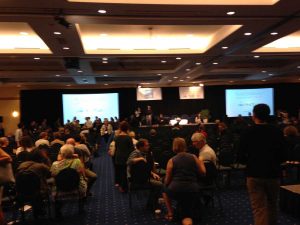
The Future of Places forum in session in the non-place of the Grand Ballroom at the Sheraton Hotel, Vancouver September 2016
When I first saw notices for a conference in Vancouver on placemaking which included a forum on “The Future of Places” in Vancouver I was intrigued. I have been thinking about time and place (heritage, tradition, the implications of environmental, economic and social trends for place, etc) for several years, and this was an opportunity to focus my thinking. I quickly learned that The Future of Places title has been used for three international conferences held since 2013 (two in Stockholm, one in Buenos Aires) to discuss placemaking and public space in sustainable urban development, and that these have been preparation for a discussion of The New Urban Agenda at the UN Habitat III conference held in Quito in October 2016. The Project for Public Spaces, based out of Washington D.C., has been very actively involved from the outset.
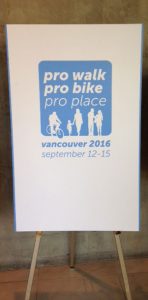 So I went to the Future of Places forum in Vancouver in September 2016 where I heard impressive arguments about placemaking and the importance of designing public spaces, borrowing heavily from the inspiration of Holly Whyte’s Social Life of Small Urban Spaces and Jan Gehl’s Life Between Buildings. The symposium was syncopated with a ProWalk/ProBike/ProPlace conference (with a trade display of electric bikes and innovative bike racks), which gives a clear indication of the scale and types of places and placemaking that are being promoted as the future of places. Despite the fact that the forum was held in the massive ballroom of a non-place conference hotel (though there were field trips to real urban places in downtown Vancouver), much of the discussion was about ways to get main streets to bustle and thrive, filled with people rather than cars. “We don’t close streets to traffic,” one participant said, neatly flipping conventional language, “we open them to people.”
So I went to the Future of Places forum in Vancouver in September 2016 where I heard impressive arguments about placemaking and the importance of designing public spaces, borrowing heavily from the inspiration of Holly Whyte’s Social Life of Small Urban Spaces and Jan Gehl’s Life Between Buildings. The symposium was syncopated with a ProWalk/ProBike/ProPlace conference (with a trade display of electric bikes and innovative bike racks), which gives a clear indication of the scale and types of places and placemaking that are being promoted as the future of places. Despite the fact that the forum was held in the massive ballroom of a non-place conference hotel (though there were field trips to real urban places in downtown Vancouver), much of the discussion was about ways to get main streets to bustle and thrive, filled with people rather than cars. “We don’t close streets to traffic,” one participant said, neatly flipping conventional language, “we open them to people.”
The grander aim of The Future of Places forum is to create a transformative urban agenda, based both on treating streets as places, and also on creating small urban spaces that strengthen equity and inclusion, use sensitive architecture, serve as innovation hubs, are well governed, sustainable and resilient (which are some of the transformative themes listed at the Future of Places website).
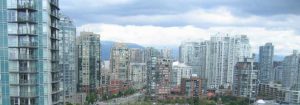
Some apartment towers in downtown Vancouver
Enthusiasm at the forum was palpable, and I agree that the particular placemaking goals being advocated are admirable, not least because I have chosen to live in a walkable, bikeable, place-oriented part of the small city of Victoria in British Columbia. Nevertheless, I have some misgivings about what I heard. From the broad perspective of place that I am exploring in this website the focus seems narrow. In the context of the variously towering and sprawling cities of the present day much seems to be missing. There was little or no consideration of automobile suburbs where most people in North America live, of industrial campuses and business parks, of homeless communities, of big box shopping plazas, of international airports, of new immigrant neighbourhoods, or of districts of apartment towers, such as those in downtown Vancouver, where half the population moves on every four or five years and communities are ephemeral.
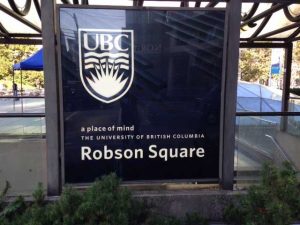
“A place of mind”. The UBC downtown campus at Robson Square, a few blocks from The Future of Places forum.
In the context of the idea of place, there was little or no consideration of personal experiences, of topophilia and topophobia, of gender differences in place experience, of mobility, of places being sequentially occupied by different cultures and social groups, of transnationalism, of the quasi-public spaces being created through public-private partnerships, of the role of media and virtual experiences of places, or of non-places and placelessness. It seems to be assumed that placemaking can be facilitated through a combination of local community participation, collaboration, and appropriate urban design. There was little discussion of the varied and powerful forces that manipulate or counter placemaking – neoliberalism, most forms of globalization, corporate and municipal branding, surveillance by CCTV, displacement, civil wars. In some degree all placemaking involves place unmaking, because somewhere regarded as unattractive or unused is being remade, and it is not necessarily the case that newly-made places are seen by everyone as an improvement on the former ones.
In a session about “The Wrong Kind of Urbanization” Patrick Condon, a professor of urban design at the University of British Columbia, did take a broader and more critical view of the future of places. He discussed what he called the next “five crucial decades of city building” during which global population is expected to continue to grow, and the proportion in cities will increase to 70-80 percent. These decades could be the last period of significant urban and economic growth and therefore offer opportunities for placemaking that may never be repeated. However, current trends of do not bode well. Economic inequities are intensifying, climate change is happening more rapidly than expected, there is a growing likelihood of global pandemics, international refugee movements are challenging political stability, intolerance is rising, and half the world’s urban population will be in what he called “flat cities” of low-rise high density developments, mostly self-built, the product of individual decisions rather than deliberate placemaking, where crowded streets, walking and cycling are the product of necessity rather than design.
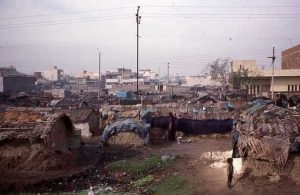
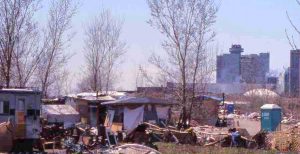
Flat cities – shanties alongside the railway north of Delhi in 1989, and a shantytown made by the homeless in Toronto in 2004 and subsequently demolished
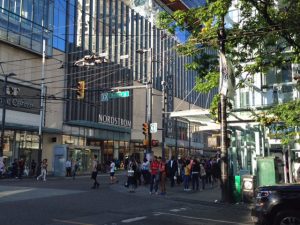
A street canyon in downtown Vancouver.
A geographically inclusive view of the future of places has to consider more than small public spaces and main streets. It has to take into account the street canyons and arterial roads of what Condon called “concentrated cities” of towers (think Dubai, Shanghai, Sydney, and downtown Vancouver) that reflect concentrations of state power and global capital, and automobile oriented suburbs, international airports, business parks, wind farms, and intermodal facilities. It has to consider changing identities of places as refugees and migrants from the South move into cities in the North, and the associated tensions and resistance to change that have already become apparent. It has to consider how much heritage can be preserved and whose heritage it is. It has to attend to transnational allegiances to several places. Climate change and rising sea levels are already changing place experiences, income inequalities manifest in gentrification are displacing populations and unmaking places occupied by communities who have lived there for generations. International tourism is turning desirable destinations into rivieras filled with AirBnBs, transient populations and service employees. It is rapidly becoming far from clear what constitutes the community responsible for collaborating in placemaking.
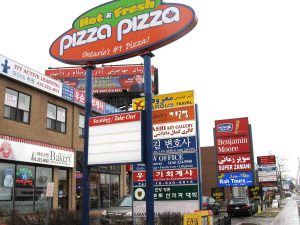
Identifying the community in places is not easy. A 1950s strip plaza in North Toronto, variously occupied by North American chains, Koreans and Iranians.
My opinion is that places and how we experience them are both in a state of enormous flux, and that the future of places is deeply uncertain. The thriving public spaces and streets envisioned by The Future of Places comprise no more that one relatively small, albeit important, aspect of what will be required to adjust to demographic, social, political and technological changes already well under way. I suspect that this era of economic stagnation, electronic interconnectedness, the apparent failure of rational government and growing environmental challenges, could be the beginning of a widespread collapse of expectations about progress, growth, and quality of everyday life. If this is the case, all types of places will have to become more resilient to unpredictable change and more self-dependent. If this is to happen without particular places descending into self-serving exclusionary enclaves, it is necessary to think of place not so much as a desirable urban form as a flexible, adaptable, pragmatic foundation for coping with environmental and social uncertainty. And from this perspective, what is important about the initiative of The Future of Places is not advocacy for small urban spaces and peopled streets; it is the seed that it is planting for models for collaboration that might be used to develop more nuanced and critical interpretations for a wide range of types of urban places and communities.
———-
Some years ago I developed some initial thoughts about a pragmatic sense of place needed to address emerging social and environmental problems. I hope to update these ideas in a future post.
Edward Relph “A Pragmatic Sense of Place” in Making Sense of Place edited by Frank Vanclay et al, Australian National Museum, Canberra, April 2008.
Edward Relph “Coping with Social and Environmental Challenges through a Pragmatic Approach to Place” in Sense of Place, Health, And Quality of Life, edited by John Eyles and Allison Williams, Ashgate, 2008